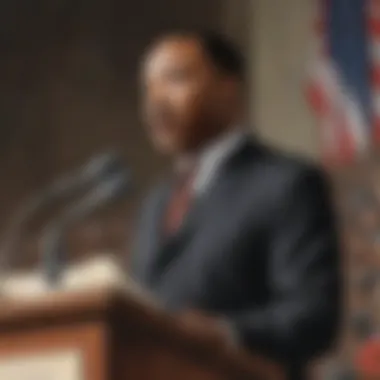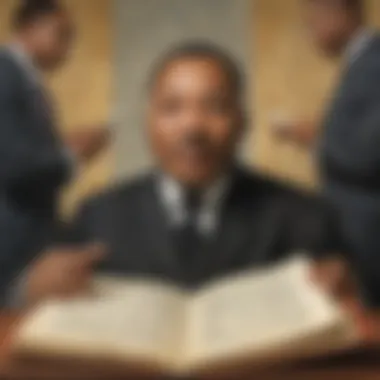Chronological Overview of Martin Luther King Jr.'s Key Achievements


Intro
The story of Martin Luther King Jr. is not just one of struggle, but also of triumph, resilience, and profound change. His achievements shaped the course of American civil rights and inspired activists worldwide. King, a man of principles and passion, dedicated his life to the relentless pursuit of justice and equality. In tracing his path, one can appreciate not only the milestones he reached but also the philosophical underpinnings that guided his journey. This article meticulously lays out a timeline of his significant accomplishments, illuminating the vibrant legacy he left behind.
From his formative years as a budding thinker to the thunderous orator who rallied the masses, King's life was marked by pivotal events that defined his approach to activism. Each step taken was a reflection of a profound desire to eradicate racial injustice and promote civil liberties. By understanding this timeline, readers can grasp the historical context of King's actions, including the societal challenges he faced and the ground he broke in the name of equality.
"Injustice anywhere is a threat to justice everywhere."
– Martin Luther King Jr.
Exploring the milestones in King's journey sheds light on how courage and commitment can challenge the status quo and create lasting change. Through this timeline, we aim to encapsulate not just King's achievements in isolation, but how they resonate in today's fight against injustice.
Preface
The importance of Martin Luther King Jr. in the American civil rights movement cannot be overstated. His achievements were not just milestones; they were beacons of hope that illuminated the path towards equality. In this article, we will explore the timeline of his key actions and their implications. The struggle for civil rights was not a simple linear journey. It was a series of events filled with triumphs and challenges, shaped by King’s ability to inspire and mobilize people around him.
King’s approach was characterized by a strong moral compass, where he believed in non-violent resistance even in the face of extreme adversity. This philosophy has since resonated through generations and remains integral in discussions about social justice today. As you navigate this timeline, you will see how each achievement aligns within a broader fabric of historical events, each thread contributing to the tapestry of American history.
The Significance of Martin Luther King Jr.
Martin Luther King Jr. was not just a leader; he was a catalyst for change. His eloquence and unwavering commitment paved the way for the eventual passage of legislative measures such as the Civil Rights Act and the Voting Rights Act. King understood that words could stir souls and motivate actions. His famous “I Have a Dream” speech is a testament to this magnitude of somehthing larger than himself — it remains a powerful indictment of injustice and a call for unity.
In an era where the narrative was often dominated by segregation and inequality, King provided a counter-narrative, advocating for justice, dignity, and respect for all. His legacy is not only rooted in what he achieved during his lifetime but also in how his vision continues to inspire the strive for equality and justice in modern times.
The Framework of This Timeline
This timeline is designed to guide you through significant phases of King’s life and activism, fitting together the pieces to form a coherent image of his remarkable journey. Each section demarcates key events while providing context and depth, reflecting the obstacles and opposition he faced, as well as his triumphs.
- Key events are elaborated with dates, showcasing significant achievements like the Montgomery Bus Boycott and the March on Washington.
- Philosophical underpinnings of King’s activism are explained to give better insight into how he developed his strategies.
- Challenges faced along the way are outlined to present a fuller picture of his tenacity and the resistance he encountered.
Through this framework, the objective is not only to celebrate King's achievements but to illuminate the ongoing challenges within the civil rights sphere, encouraging readers to reflect on where we stand today in relation to the ideals King espoused. Capturing these pivotal moments will help you appreciate their relevance and spur your engagement with the continued fight for social justice.
Early Life and Influences
The early life of Martin Luther King Jr. is foundational in understanding his approach to activism. This period shaped his beliefs, values, and ultimately the path he chose to fight for civil rights. From his family dynamics to his educational experiences, these influences were instrumental in forming the man who would become a pivotal figure in the movement for racial equality.
Birth and Family Background
Martin Luther King Jr. was born on January 15, 1929, in Atlanta, Georgia. He was the first child of Martin Luther King Sr., a prominent pastor, and Alberta Williams King, a talented musician. Growing up in a deeply religious household instilled in him a sense of moral duty and the importance of community. His father was a guiding force—a man who firmly believed in the Bible and stood against the unfair treatment of Black individuals. This moral upbringing laid a cornerstone that would later influence King’s thoughts on justice.
As a product of the segregated South, King witnessed racial injustice firsthand. His neighborhood was riddled with the inequalities of Jim Crow laws. Yet, he also found beauty and love within his family and community. Engaging in debates over social issues with his father and mother at the kitchen table nurtured his passion for civil rights. King once reflected that there was "an air of expectation and alliance" in his family, fostering a strong belief in activism and advocacy.
This duality of experiencing both warmth and discrimination would later reflect in his activism style. He recognized that love was a vital weapon against hate—a theme that emerged prominently in his speeches.
Educational Milestones
King's educational journey began at an early age. He was a bright child—no surprise there, given the intellectual environment at home. He attended the local black public school and excelled in his studies, often skipping grades due to his brilliance. At just fifteen, he enrolled at Morehouse College, a historically Black institution that became a significant platform for his academic and spiritual growth.
While at Morehouse, King was deeply influenced by the writings of Henry David Thoreau, particularly his essay on civil disobedience. It was here that his ideology began taking shape. Surrounded by passionate individuals who shared his vision for equality and justice, he began to formulate his approach—one that was rooted in nonviolent principles.
Later, King earned a divinity degree from Crozer Theological Seminary in Pennsylvania, where he cultivated his thoughts on social justice and further explored Gandhi's philosophies. His time in seminary also taught him to approach social change with both intellect and spirituality, essential components in his future efforts:
- Emphasizing love and respect for all individuals
- Highlighting the need for change through peaceful means
- Grasping the philosophical underpinnings of social movements


These educational experiences shaped King's world view and would directly inform his strategies for the Civil Rights Movement. He recognized the power of education for social empowerment, a belief he upheld throughout his life.
"The function of education is to teach one to think intensively and to think critically. Intelligence plus character—that is the goal of true education."
Initial Foray into Activism
The initial strides Martin Luther King Jr. took into the world of activism were not only monumental events in his life but also critical turning points in the broader civil rights movement. This early phase set the stage for his later, well-known campaigns and showcased the foundational beliefs that would inform his approach to activism. King’s involvement highlighted the necessity for direct action in the fight against systemic racism and injustice. These episodes of his life reflect how he began to rally support within the African American community and sought to connect with allies from various backgrounds.
Montgomery Bus Boycott
The Montgomery Bus Boycott, which took place from December 5, 1955, to December 20, 1956, was instrumental in shaping King's trajectory as a civil rights leader. It all began with the infamous arrest of Rosa Parks for refusing to give up her seat to a white man. King's leadership during the boycott was a blend of tactical planning and moral conviction. He urged the African American community in Montgomery to unite, advocating for a boycott of the bus system to protest against segregation policies.
"Injustice anywhere is a threat to justice everywhere."
— Martin Luther King Jr.
As a result of this powerful demonstration of solidarity, the boycott lasted a remarkable 381 days. King, alongside other leaders, faced numerous challenges — threats to their safety, economic hardship for participants, and legal battles. Through organized carpooling and walking, the community remained committed, illustrating their resilience.
The success of the Montgomery Bus Boycott was a triumph for nonviolent protest. The local and national attention it garnered showcased the power of collective action against racial inequality. Following the boycott, the Supreme Court ruled that racial segregation on public buses was unconstitutional, marking a significant legal victory for the civil rights movement. This experience solidified King’s belief in nonviolent resistance as a powerful tool for change.
Formation of the Southern Christian Leadership Conference
Following the success of the bus boycott, in 1957, Martin Luther King Jr. and several other influential African American leaders founded the Southern Christian Leadership Conference (SCLC). The idea behind the SCLC was to harness the moral authority of the churches and integrate it with effective activism. This organization aimed to coordinate and promote civil rights initiatives across the South while also providing a structured environment for upcoming leaders.
King’s role in the formation of the SCLC wasn't merely administrative; he became its first president. This position allowed him to shape its direction and philosophy actively. The SCLC emphasized nonviolent protest and appealed to Christian ideals as a central tenet in the fight for equality.
The establishment of the SCLC was pivotal for many reasons:
- Leadership Development: It created a platform for burgeoning leaders like Ella Baker and Andrew Young to emerge and contribute.
- Strategic Planning: It facilitated a coordinated response to civil rights issues, significantly enhancing the impact of their activism.
- Broader Reach: This organized entity brought together various grassroots organizations, allowing for unified efforts against discrimination.
This period of activism showcases how King strategically utilized the lessons learned from earlier efforts, guiding collective action towards significant social change. King's initial foray into activism was marked by a blend of immediate action and long-term planning, laying the groundwork for the broader civil rights movement.
Key Milestones in the Civil Rights Movement
The story of Martin Luther King Jr. is deeply intertwined with the broader narrative of the Civil Rights Movement in the United States. His role in significant events not only outlines his contributions but also reflects the struggles and triumphs of countless individuals seeking justice. The milestones achieved during this period were not merely events; they were points of transformation that galvanized a nation and inspired the world. In this section, we explore some of the pinnacle moments that defined King's journey and the movement at large, highlighting how these achievements forged pathways for future generations.
March on Washington
Content of the ' Have a Dream' Speech
At the heart of the March on Washington stood one of the most iconic speeches in history: Martin Luther King's 'I Have a Dream.' Delivered on August 28, 1963, this speech encapsulated the aspirations and hopes of a generation yearning for equality. It was more than just a call for civil rights; it was a vivid imagination of the future, a vision where children would not be judged by the color of their skin but by the content of their character. This powerful message resonated widely, becoming a rallying cry for those advocating for social change.
Notably, the speech’s lyrical quality and poetic cadence distinguish it from other addresses. It reached beyond mere political demands; it tapped into the emotional landscape of a troubled nation. "I have a dream that one day" became a repeated motif, stirring feelings of hope and unity among millions. The imagery invoked painted a vivid picture of freedom and justice, making it a choice example for discussing King's legacy. Its impact stretched far beyond the boundaries of the event itself, embedding itself deeply into the American ethos.
"I have a dream today!"
This pivotal speech is often credited with transforming public perception regarding the civil rights cause, showcasing the potential for a peaceful movement. However, while it remains a cornerstone of King's legacy, it also invites discourse about its reception and the hurdles that followed. Many critics have pointed out that while it inspired movements, it did not dismantle systemic racism overnight.
Significance of the March
The significance of the March on Washington extends beyond the mere act of gathering thousands in the nation's capital. It represented a united front against racial injustice and showcased the collective strength of various civil rights organizations coming together for a common cause. The event was not just a protest; it was a demonstration of solidarity among diverse groups striving for a common goal. The attendance of over 250,000 people marked it as one of the largest rallies for human rights in United States history, underscoring a widespread demand for change.
The march is often highlighted because it served as a pivotal moment in the fight for civil rights. It heightened awareness of systemic inequalities faced by African Americans and pressed the federal government to take significant action. The solidarity displayed during this event was essential for igniting discussions in the Senate about civil rights legislation, paving the way for the eventual passing of the Civil Rights Act of 1964.
However, it's important to acknowledge that while the march successfully drew attention to civil rights issues, it revealed divisions within the movement itself regarding strategies and goals. The diversity in opinions highlighted the complexity of the struggle, with different factions advocating various approaches.


Nobel Peace Prize
The Impact of Winning the Prize
Receiving the Nobel Peace Prize in 1964 was a remarkable achievement for Martin Luther King Jr., bringing international recognition to not only his work but also the Civil Rights Movement. This accolade underscored the global acknowledgment of the injustices faced by African Americans and the importance of their struggle. King's commitment to nonviolence earned him the prize, reinforcing the notion that peaceful protest could elicit significant social change.
The award also provided King with a larger platform to elevate the cause, enabling him to share his message with audiences far and wide. It connected the civil rights movement to a broader spectrum of peace and justice struggles around the world, illustrating that the fight for equality was a universal endeavor. This recognition spurred momentum for future civil rights initiatives, as it underscored the pressing need for international solidarity in the quest for justice.
However, the award was not without complications; it heightened expectations for King's approach and often placed him in the crosshairs of critics who expected immediate results.
Remarks During Acceptance Speech
Martin Luther King Jr.’s acceptance speech for the Nobel Peace Prize delivered a profound message that encapsulated his philosophy and commitment to nonviolent resistance. In his address, King emphasized the interconnectedness of all humanity and the idea that injustice anywhere is a threat to justice everywhere. This statement remains a powerful reminder of the collective responsibility we hold toward one another across the globe.
His remarks resonated with depth and urgency, clearly articulating that peace cannot be attained through mere absence of violence but rather through the presence of justice. Such an outlook is a pivotal choice that exemplifies the importance of not only individual advocacy but also the necessity for community and international engagement in the pursuit of social transformation. King's voice during this occasion highlighted the need to remain steadfast and courageous in the face of adversity.
The speech bore unique features, showcasing King's visionary ideals fused with a pragmatic understanding of the challenges that lay ahead. His emphasis on love and understanding challenged continuing cycles of hate and division that plagued society, emphasizing a holistic approach to activism. While the speech celebrated the moment, it also laid bare the hard work that remained, illustrating the duality of triumph and ongoing struggle in the quest for equality.
Philosophical Foundations
The philosophical foundations of Martin Luther King Jr.'s work are significant in understanding the essence of his activism and the overarching impact he had on the Civil Rights Movement. King's thoughts were not just random musings; they were rooted deeply in principles that guided his path and actions. The intersection of morality and action forms the crux of this section. Examining these foundations helps to illuminate how King managed to rally countless individuals around the cause of social justice while navigating numerous hurdles along the way.
Influence of Gandhi’s Principles
One cannot delve into King's philosophy without acknowledging the monumental influence of Mahatma Gandhi. King saw Gandhi's approach to social justice as a beacon of hope. Gandhi's insistence on nonviolence and his emphasis on love as a transformative weapon resonated deeply with King. Many observe how King practiced this principle meticulously, choosing love over hate even when faced with extreme hostility.
King's early visit to India in 1959 solidified his admiration for Gandhi. He believed that Gandhi’s philosophy could be adapted to the American social landscape, emphasizing the necessity of peaceful protests and civil disobedience. It was not merely about achieving civil rights; it was about establishing moral clarity in the face of oppression.
"Nonviolence is a powerful and just weapon, which cuts without wounding and ennobles the man who wields it.” This quote by King distills the essence of his admiration for Gandhi's teachings. King drew a stark line between violence, which breeds more violence, and nonviolence, which fosters understanding and reconciliation.
Development of Nonviolent Resistance
The concept of nonviolent resistance served as a cornerstone of King’s methodology, transforming how protests were organized and executed. He strategically believed that through nonviolent means, the fight for civil rights would not only highlight the moral high ground of African Americans but also compel the general populace to confront the stark realities of racial injustice.
King's approach was both tactical and philosophical. He recognized that violence would only serve to deepen social divides and strengthen opposition. Instead, he empowered his followers to remain steadfast through hardships and aggression. Key events, such as the Montgomery Bus Boycott, showcased this approach effectively, as activists stood firm in their demands without resorting to violence.
Through workshops and training sessions, King and his supporters taught communities about the power of nonviolent resistance. They emphasized methods like peaceful marches and sit-ins. This education was crucial, as it prepared those involved to confront hostile reactions with dignity and restraint.
In essence, King’s philosophical framework, heavily influenced by Gandhi, outlined a clear path to social change that was both ethical and practical. He masterfully linked theory to action, ensuring that his message of equality was not only heard but felt across the nation.
Challenges and Controversies
The journey of Martin Luther King Jr. was not a smooth path paved with accolades and applause. Amidst the glorious milestones of the Civil Rights Movement, various challenges and controversies emerged that shaped his activism. These elements, often overshadowed by his illustrious victories, play a crucial role in understanding King's legacy. The hurdles he faced from authority and within his movement often tested his resolve and commitment to his cause. Addressing these challenges provides clarity on how King navigated tumultuous waters while striving for justice and equality.
Opposition from Government and Law Enforcement
King's approach to civil rights didn't settle well with many in positions of power. The U.S. government and local law enforcement agencies viewed him with suspicion and outright hostility. This opposition was more than mere annoyance; it was systematic and deeply entrenched in the societal norms of the time.
During the height of his activism, FBI Director J. Edgar Hoover saw King as a significant threat. The Bureau conducted surveillance on him, hoping to uncover any misconduct. This was not just about keeping tabs on a civic leader; it was part of a broader strategy to undermine the civil rights movement itself.
- Surveillance and Harassment: King was subjected to intense scrutiny, which included wiretaps and attempts to discredit him publicly. These tactics serve as a reminder of the lengths to which some government officials went to suppress voices advocating for change.
- Violent Backlash: Law enforcement often met peaceful protests with violence. The brutality seen in events like the Birmingham campaign highlighted the stark reality facing civil rights activists who merely sought basic human rights. King’s demonstrations faced fierce opposition, leading to arrests and physical confrontations with police forces.


As King often remarked, to fight for justice in such a context made every step forward feel like climbing a mountain; the struggles outlined the true essence of resilience.
Internal Conflicts within the Civil Rights Movement
Not all battles King faced came from external enemies. Inside the civil rights movement, differing ideologies and strategies created tension among activists.
Groups like the Student Nonviolent Coordinating Committee (SNCC) and the Southern Christian Leadership Conference (SCLC), which King co-founded, had different views on how to approach activism. While King emphasized nonviolence and dialogue, some younger activists advocated for more radical measures. This generational divide often led to disagreements that threatened to splinter the movement.
- Ideological Strains: The debates around tactics showcased a fundamental shift in how the movement could progress. Some believed that the slow and steady approach advocated by King was ineffective in the face of escalating violence.
- Personal Relationship Strain: Interpersonal dynamics also became strained. Tension existed not only among groups but also personally between leaders, leading to public disagreements that sometimes overshadowed the movement's goals.
"At the core, these internal conflicts did not diminish King's impact but instead forced him to adapt his strategies for coalition-building, aiming to unify a diverse group of people under one voice—transforming our struggles into shared triumphs."
The unfolding narrative of Martin Luther King Jr.’s life reveals that the journey towards civil rights was fraught with contradictions, debates, and various challenges. Understanding these complexities is paramount to appreciating his profound legacy.
Legacy and Continuing Impact
The legacy of Martin Luther King Jr. extends far beyond the immediate impacts of his activism during the Civil Rights Movement. His contributions fostered a climate where discussions about race, justice, and equality are still navigated today. The values he championed are not just historical markers; they are pillars that hold up ongoing battles against inequality and injustice.
Influence on Future Generations
King’s influence doesn’t just reside in textbooks or docu-series. It permeates the fabric of modern activism. Young people today often draw inspiration from his speeches, writings, and methods. Significant social movements, such as Black Lives Matter, have sought to replicate King’s tactics of peaceful protest while adapting them for the digital age. This blend creates a fusion of old and new, echoing his philosophies while addressing contemporary issues.
King’s legacy serves as a guiding compass. For instance, students and educators often reference his words during discussions on injustice and civil rights. Schools dedicate spaces to celebrate him, ensuring the next generations grasp the significance of his work.
In ways big and small, King’s dream becomes a reality as countless individuals and groups work tirelessly for change, echoing themes of unity and equality he passionately promoted. As future leaders emerge, they carry with them the weight of his ideals, shaping how they approach advocacy.
Holidays and Memorials Honoring King
One cannot overlook the societal recognition of King through public holidays and memorials. Martin Luther King Jr. Day, observed on the third Monday of January, stands as a national tribute. It’s more than just a day off for many; it's a call to action. Various communities engage in service projects, reflecting King’s philosophy that private troubles are tied to public issues.
Memorials, like the Martin Luther King Jr. Memorial on the National Mall in Washington, D.C., solidify his place in American history. These physical reminders serve not only as a tribute to his fight for civil rights but also as a challenge to visitors regarding their roles in continuing that fight today.
"Life's most persistent and urgent question is, 'What are you doing for others?'"
Additionally, many local parks, streets, and schools are named in his honor, reinforcing his commitment to community and equality. These spaces are vital for educating youth about his legacy, making them a lived experience rather than just an abstract concept.
The existence of such holidays and memorials nurtures a culture of remembrance and reinforces King’s principles of service, justice, and active participation in society. It keeps his message alive and relevant, echoing through time as a banner for those striving to live out the ideals he fought for.
Final Thoughts
In closing, the exploration of Martin Luther King Jr.’s journey is not just an account of historical milestones; it serves as a reminder of the ongoing struggle for equality and justice that resonates today. King’s unwavering commitment to nonviolence and civil rights provides a compass for contemporary activism. By reflecting on his approach, we not only honor his legacy but also challenge ourselves to think critically about the issues that still plague our society.
Reflections on King’s Approach to Activism
Martin Luther King Jr. adopted a strategic and deeply philosophical approach to activism, which was influenced by the principles of nonviolent resistance. His methods were grounded in a moral framework that sought to elevate human dignity through peaceful means. King believed that real change could not be obtained through violence, as it breeds more violence and hatred. Instead, he emphasized the importance of love and understanding.
King’s philosophy was reminiscent of Gandhian principles, yet he adapted them to the American social context. He articulated the belief that one could fight oppression without resorting to hostility. His famous quote, "Darkness cannot drive out darkness; only light can do that. Hate cannot drive out hate; only love can do that," encapsulates this ethos. King’s speeches and writings reflect a profound moral commitment that was both accessible and deeply contemplative, providing a blueprint for future generations eager to engage in social justice.
Wrestling with the practical challenges faced during the Civil Rights Movement, King’s decisions were not easy, and there were times when dissent within the ranks surfaced. Nevertheless, his commitment to peaceful protest serves as a testament to his character and vision. He recognized that activists often walk a difficult line, balancing the urgency of action with the principles of justice.
The Persistent Relevance of King's Message
The message of Martin Luther King Jr. remains strikingly pertinent in today's world, where issues of inequality and prejudice still haunt societies globally. His dreams for a more equitable society resonate at various points of conflict—be it racial injustices, gender inequality, or economic disparities. King’s teachings encourage us to critique the systems that uphold these inequalities, pushing us to advocate relentlessly for change.
In educational settings, his words are woven into the fabric of discussions around civil rights and ethics. Lessons derived from his life serve as pivotal points for educators, offering students a lens through which to view the historical struggle against oppression. Parents can utilize his principles to instill values of empathy and respect in their children, fostering a more inclusive environment from a young age.
Moreover, social media platforms provide an arena for dialogue that King would likely embrace. Activists leverage technology to raise awareness and mobilize support, creating an echo chamber for King’s principles of activism. Campaigns today often reflect his ideals, demonstrating that while the methodology may evolve, the core message remains timeless.
"The time is always right to do what is right."
This quote serves as a rallying cry in conversations about social justice, encouraging individuals to take actionable steps against injustice.















